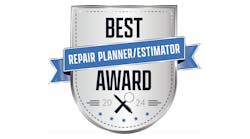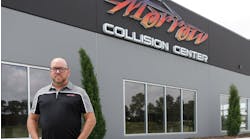More and more programs are becoming available to help shops track and capture the actual cost of supplies during a repair. I have tried a handful of the programs, and while each of them has features I like and find useful I haven’t found one I am fully committed to yet. Recently, we signed up for 3M’s Repair Stack and EagleMMS. The 3M Repair Stack is meant to help track and reorder inventory along with a feature built-in meant to help track supplies used on specific repair orders. While EagleMMS is specifically designed to capture paint and body supplies on each repair order by generating invoices but doesn’t track actual use. The programs are similar in that they are meant to capture more money from the insurance industry on items that we have traditionally been letting slide through the cracks.
Eagle MMS has a reasonable price point, which I greatly appreciate. Its focus is to generate invoices for paint and body supplies based on the paint line you use, the paint code you are spraying, the vehicle size, and what repair work you are completing on the vehicle. To generate an invoice you put all the vehicle information in the system, along with the paint code. A vehicle diagram is displayed and you mark what areas of the vehicle are being painted. Then you go through a list of operations and select which operations are being performed. Each operation is assigned to a pre-defined kit that includes items like sandpaper, body filler, buffing pads, etc. Anything that you would use for that operation is set up in these kits. The system then generates an invoice for all the supplies you should need for the operations you told it you are performing.
What I like about the invoice it generates is it shows your vehicle information, paint code, a diagram of the vehicle and then for all the supplies you use it shows the logo for the supply brand. If you are using 3M tape, it has a 3M logo next to the description. If you are mixing PPG paint then it shows the PPG logo next to each toner that would have been used in the mix. The program does have some features that you can customize to your shop. During setup they take into account what paint line you are spraying and the cost and input what percentage you would like to mark everything up to. It lets you add products if you need to but for the most part, all the kits already account for most repair procedures you will be performing. It will also let you add your company's logo and information to be listed on the invoice.
Best Practice: I found for our shop the best practice is to not add our company's logo onto the invoice with our shop information. We opted to put our jobber's logo and information where our information would generally be, and we removed the EagleMMS details and logo. This way the very professional-looking invoice looks like it is an invoice that was given to us by our jobber and not necessarily one we generated. We just found that it generates fewer questions from the insurance companies when we present it this way.
When we do present the invoice to the insurance companies, we let them know that we are requesting the difference in paint and supplies and generally do this by adding a line item for the difference and adding this wording to the line item as a note: “Additional Paint & Supplies are requested. Estimating software like CCC, Mitchell, and Audatex base Paint & Supplies off an estimated average of what is needed to paint the repaired areas of a vehicle, since cost of the specific toners for the paint code and actual invoices for supplies are not available. We are providing detailed invoices for Paint & Supplies so the repair cost can be calculated off of the actual cost of product and not an estimated cost for the industry.”
3M’s RepairStack has similarities to EagleMMS but we find they complement each other. 3M RepairStack is an inventory system that tracks your supplies but also lets your techs assign RO’s to the supplies they are removing from inventory. The beauty of RepairStack is that it not only produces invoices for supplies but can be integrated into CCC and those supplies costs go directly into the Repair Order. Now RepairStack is a bit more costly for us at $213.20 per month and we had to sign a two-year contract. When you sign the contract you do receive a supply closet and you can negotiate to receive other benefits to make signing a two-year contract worthwhile, so negotiate.
What I like about RepairStack is I can add products into the system and I can decide what items I want to track for Repair Orders. If I want to track and invoice for sandpaper and not tape then I can do that. What we use it for is to track specific supply costs for repair orders that may not be included in the EagleMMS program. Examples would be adhesive promotor wipes, undercoating, clips, etc. We have almost everything in our inventory set to be added to the Repair Order so it all goes into our CCC. Then at the end of the repair, we can look through our parts lists and decide what we are actually going to add to the estimate and what is already included with the EagleMMS invoice.
Recommendation: We didn’t want to have to input and make a scan bar for all of our clips, screws, retainers, and small items, so what we did was sort of create a hot sheet. We grouped together small retainers and clips and made a bar code for them and inputted the average cost. I ended up making 10 categories of items that were similar in cost and use. I taped the bar codes with pictures of what is included in each group to the front of our RepairStack cabinet because it is right next to our clips drawers. That way when a tech pulls clips or retainers from there they can just scan the correct barcode for what group it's in and how many they pulled out and the cost goes directly into our CCC repair order for that vehicle.
Ultimately I look at the two programs this way. Was I billing for everything we were using before RepairStack and EagleMMS? The answer is I was attempting to and I was pretty successful but I am sure we missed things. By spending an extra $300 per month to utilize both programs I know we are more accurate in getting everything we used onto the Repair Orders and recovering costs that maybe I haven’t thought about in the past or didn’t know how to bill for. We’ve been using both programs for 3 months now and I can tell you that my average Repair Order cost has increased by almost $400. So each month I recover the investment I’ve made for that month in just one Repair Order, which I don’t think is too shabby.



